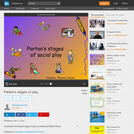
This powerpoint highlights the stages of play as posited by Mildred Parten (1932)
- Subject:
- Arts and Humanities
- Material Type:
- Lecture Notes
- Author:
- Theresa Brown
- Date Added:
- 04/11/2013

This powerpoint highlights the stages of play as posited by Mildred Parten (1932)
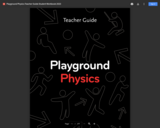
Playground Physics is an iPad and Progressive Web application (app) developed by the New York Hall of Science. The app is accompanied by a supplemental Teacher Guide for middle school teachers. The Playground Physics curriculum is a six-week supplemental physics curriculum, designed to be used alongside any existing science curricula in the middle grades. It includes a teacher guide and student work, and maps to the NGSS and NYSSLS. The curriculum is focused around three different units which each explore a major concept in physics (motion, force and energy) through a specific type of physical play (catching a ball, jumping, swinging).
Playground Physics is particularly well suited to supporting diverse learners because it leverages students’ abilities to playfully ask and answer their own questions to connect academic content to what they notice, describe and analyze about their own individual actions. Additionally, the multimodal nature of the program, which uses videos and images as well as kinesthetic exploration to build understanding, is less text-dependent than more traditional physics instructional materials.

This course provides continued work in the development of play scripts for the theater. Writers work on sustained pieces in weekly workshop meetings, individual consultation with the instructor, and in collaboration with student actors, directors, and designers. Fully developed scripts are eligible for inclusion in the Playwrights’ Workshop Production.
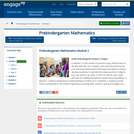
In Module 2, in the context of classroom play, children learn to identify, describe, sort, compare, and create two-dimensional (2-D) and three-dimensional (3-D) shapes and objects. Children develop vocabulary to describe the relative position of objects (e.g., top, bottom, up, down, in front of, behind, over, under, and next to), building foundational spatial reasoning abilities. In Module 1, students developed an understanding of numbers to 5. In Module 2, students practice these counting skills in the context of geometry (counting sides, corners, a group of triangles, etc.).

It is an assignment on English Literature. The main purpose is to assess the knowledge of the students studing English Literature.
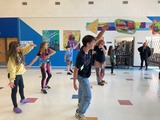
Synopsis: A salmon hatches from its egg, making the perilous journey downstream into the ocean and adulthood. Along the way, they find courage and purpose in a sometimes scary world. Themes: Salmonid ecology, cooperation, emotional well-being, self-regulation
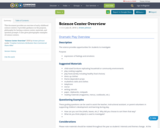
This document provides an overview of early childhood science centers. It provides guidance on the purpose, philosophy for having a science center, materials, and question prompts. It also gives photographic examples of science centers.

This game is designed to test, reinforce, and enhance students' understanding of Social Security Law. I've used it in several different ways: as a game that students play in class, with a prize for the winning student or team (playing the game and discussing the correct answers takes about one hour of class time); as a closed-book quiz that students take in class, followed by discussion of the correct answers (again, about one hour of class time); and as an open-book assignment that students complete before class, followed by discussion of the correct answers in class (about 30 minutes of class time).
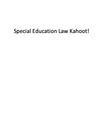
This game is designed to test, reinforce, and enhance students' understanding of Special Education Law. I've used it in several different ways: as a game that students play in class, with a prize for the winning student or team (playing the game and discussing the correct answers takes about one hour of class time); as a closed-book quiz that students take in class, followed by discussion of the correct answers (again, about one hour of class time); and as an open-book assignment that students complete before class, followed by discussion of the correct answers in class (about 30 minutes of class time).
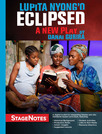
This StageNotes® education guide includes lessons in History, Langauge Arts, Social Emotional Learning, and the Arts to be used in conjunction with an exploration of the Broadway play, Eclipsed.

Taking as its starting point the works of one of Britain’s most respected, prolific—and funny—living dramatists, this seminar will explore a wide range of knowledge in fields such as math, philosophy, politics, history and art. The careful reading and discussion of plays by (Sir) Tom Stoppard and some of his most compelling contemporaries (including Caryl Churchill, Anna Deveare Smith and Howard Barker) will allow us to time-travel and explore other cultures, and to think about the medium of drama as well as one writer’s work in depth. Some seminar participants will report on earlier plays that influenced these writers, others will research everything from Lord Byron’s poetry to the bridges of Konigsberg, from Dadaism to Charter 77. Employing a variety of critical approaches (both theoretical and theatrical), we will consider what postmodernity means, as applied to these plays. In the process, we will analyze how drama connects with both the culture it represents and that which it addresses in performance. We will also explore the wit and verbal energy of these contemporary dramatists…not to mention, how Fermat’s theorem, classical translation, and chaos theory become the stuff of stage comedy.

Directed practice in acting, directing, or design on a sustained theater piece, either one-act or full length, from pre-rehearsal preparation to workshop production.

Directed practice in acting, production, or design on a sustained theater piece, either one-act or full length, from pre-rehearsal preparation to workshop production. Consult Theater Arts Office. Includes directed practice in stagecraft. Dramashop rehearses a production of Eric Bogosian’s play “subUrbia” for presentation the first two weekends in February. Visiting artist, David R. Gammons, directs. Approximately 10 roles filled by auditions. Students can receive up to six credits for acting or technical positions. Schedule of rehearsals to be arranged, but actors should be available during the afternoon. Students must be available for performances in early February. This course is offered during the Independent Activities Period (IAP), which is a special 4-week term at MIT that runs from the first week of January until the end of the month.
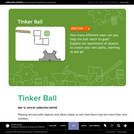
Exploratory play is about asking questions: “What happens when I do this?” “What if I did it this way?” Experimenting with materials and pushing their limits encourages us to consider a wide range of possibilities when problem-solving. Playing around with objects and ideas helps us see that there may be more than one solution.

Toy Product Design is a MIT Public Service Center service learning design course offered in the Spring semester. This course, previously listed as SP.778, is an introduction to the product design process with a focus on designing for play and entertainment.
In this course, students work in small teams of 5-6 members to design and prototype new toys. Students work closely with a local sponsor, an elementary school, and experienced mentors on a themed toy design project. Students will be introduced to the product development process, including determining customer needs; brainstorming; estimation; sketching; sketch modeling; concept development; design aesthetics; detailed design; prototyping; and written, visual, and oral communication.
At the end of the course, students present their toy products at the Playsentations to toy designers, engineers, elementary school children and the MIT community.
For more information about this course, see the 2.00B Web site.

This document provides a rationale of the importance for using centers in early childhood classrooms. An explanation of the teacher's role is provided along with several resources that are available to teachers for creating a variety of center activities.
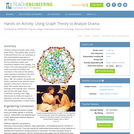
Students analyze dramatic works using graph theory. They gather data, record it in Microsoft Excel and use Cytoscape (a free, downloadable application) to generate graphs that visually illustrate the key characters (nodes) and connections between them (edges). The nodes in the Cytoscape graphs are color-coded and sized according to the importance of the node (in this activity nodes represent characters in the work and their relative importance to the story). After the analysis, the graphs are further examined to see what the visual depiction of the story in the form of a graph tells readers about the inner workings of the dramatic work. Students gain practice with graph theory vocabulary, including node, edge, betweeness centrality and degree on interaction, and learn about a range of engineering applications of graph theory.
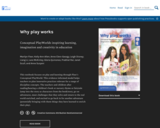
This textbook focuses on play and learning through Fleer's Conceptual PlayWorld. This evidence informed model helps teachers to plan innovative practices relevant for a range of discipline concepts. The teachers and children after reading/hearing a children’s book or nursery rhyme or fairytale jump into the story as characters from the book/story, go on adventures, meet challenges that they solve and return to the real world enriched, and excited to go back in for another adventure (potentially bringing with them things they have learned to enrich their play).